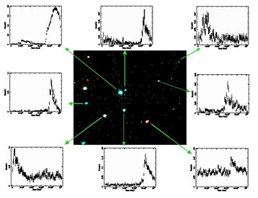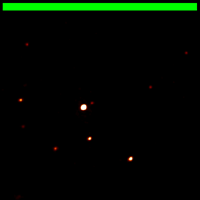November 8, 2000
CXC PR: 00-27
Stars, like babies, make quite a fuss in their first days after birth. Astronomers using the Chandra X-ray Observatory have discovered that protostars--stars in their youngest, "neonatal" stage--are marked by powerful X rays from plasma ten times hotter and 100 to 100,000 times brighter than the flares on our Sun. This is all long before their nuclear furnaces of hydrogen even ignite, the mark of stellar maturity.
The X-ray flares have also provided the closest look yet at the youngest stars in the universe, never before detected because they are hidden within dust and molecular clouds that filter all other types of light.
Yohko Tsuboi of the Pennsylvania State University (Penn State) presents these findings today in a press conference at the meeting of the High Energy Astrophysics Division of the American Astronomical Society in Honolulu, Hawaii.
"We peered at newborn stars deeply embedded in their cradle and found that their crying is much more tumultuous than we expected," said Tsuboi. "With Chandra, we now have a new tool to examine protostars, which have been impossible to gain access to in any other wavelength."

1 square light years field X-ray image around rho Ophiuchi molecular cloud core. Red colorrepresents less absorbed X rays, while blue represents absorbed X rays. Lightcurves for each sources are also shown.
The image is from the Chandra X-ray Observatory, which features a molecular cloud and protostars called the rho Ophiuchi molecular cloud core. Stars, like babies, make quite a fuss in their first days after birth. Astronomers using the Chandra X-ray Observatory discovered that protostars — stars in their youngest, "neonatal" stage — are marked by powerful X rays from plasma ten times hotter and 100 to 100,000 times brighter than the flares on our Sun. This is all long before their nuclear furnaces of hydrogen even ignite, the mark of stellar maturity. The image of rho Ophiuchi can be compared to a jigsaw puzzle, with 8 small black and white light curves in boxes arranged around the central X-ray image of a black square with some brightly colored spots.
Tsuboi and her collaborators looked at the two youngest types of protostars: Class-0 (zero) protostars, about 10,000 years old; and Class-I protostars, about 100,000 years old. In human terms, these protostars are like one-hour-old and 10-hour-old babies, respectively.
The transition from one class to another is marked by changes in the protostar's infrared spectrum as the gas and dust envelope diminishes. The envelope has been well studied by infrared and radio astronomers. Protostars themselves and their most extreme activities, however, have remained hidden until now, embedded in the dense envelopes.
Previous X-ray telescopes--namely the Japan-U.S. Advanced Satellite for Cosmology and Astrophysics and the German-UK-US Roentgen Satellite--discovered sporadic X rays from several Class-I protostars. These satellites did not have enough spatial resolution nor sensitivity, however, to resolve the large percentage of protostars deep inside crowded cloud cores.

Movie in X-ray band of rho Ophiuchi molecular cloud core F. The green bar
indicates the time from 0 hours to 27 hours by the length.
(Click Image to View Movie)
With Chandra, astronomers from Penn State and Kyoto University in Japan have detected X rays from 17 Class-I protostars in a region with 22 known "infrared" Class-I sources. These protostars are located in the rho Ophiuchi molecular cloud 500 light years from Earth in constellation Ophiuchi. The astronomers also saw nearly a dozen X-ray flares over a 27-hour period (*see figure 1 and movie).
"Virtually all the Class I protostars in the rho molecular cloud may emit X rays with extremely violent and frequent flare activity," said Kensuke Imanishi of Kyoto University, lead investigator of the rho Ophiuchi observation. "The X-ray fluxes in the flares we saw were up to 10,000 to 100,000 brighter than those in our Sun's flares."
Probing deeply with Chandra into a different star-formation region, 1400 light years from Earth in constellation Orion, a second team of astronomers led by Tsuboi observed for the first time activity from Class-0 protostars. Up until now, only the protostar envelope had been seen. In the Class-0 phase, a dense molecular cloud and heavy accretion of gas onto the newly forming star enshroud the region and attenuate even the most penetrating X rays. Chandra, however, had the sensitivity to detect X-ray activity.
"The X rays are heavily absorbed, possibly by a large amount of cloud gas," said Tsuboi. "It proves that the X rays come really from the center of the cloud core, from the protostar itself. We therefore discovered X rays even in the Class-0 phase."
"Far beyond our imagination, a star immediately after the birth at the center of a cold molecular core at temperatures of only a few tens of Kelvin [-400 degrees Fahrenheit] frequently generates very hot plasma with 10 to 100 million Kelvin," said Katsuji Koyama of Kyoto University, director of these two observations.
Koyama said that the violent X-ray flares on protostars may be generated by a coupled action of stellar spin and convection. These become less active as a star condenses to ignite the hydrogen burning and finally settles to a quiet phase like the Sun.
In fact, our Sun was born about five billion years ago in a molecular cloud core, which also created the rest of the solar system, including the Earth. The infant Sun may have also been prone to fierce X-ray tantrums. Once the Sun's core was hot and dense enough to initiate hydrogen fusion, after about a few million years, the Sun became a steadier source of energy. This steadiness could have been what allowed life to develop on Earth.
The research team for the Orion Molecular Clouds also includes Kenji Hamaguchi at Kyoto University; Ken'ichi Tatematsu and Yutaro Sekimoto at Nobeyama Radio Observatory, National Astronomical Observatory of Japan; and John Bally and Bo Reipurth at University of Colorado.
The Chandra observations were made using the Advanced CCD Imaging Spectrometer (ACIS), conceived and developed for NASA by Penn State and Massachusetts Institute of Technology under the leadership of Penn State Professor Gordon Garmire. NASA's Marshall Space Flight Center in Huntsville, Ala., manages the Chandra program. TRW, Inc., Redondo Beach, California, is the prime contractor for the spacecraft. The Smithsonian's Chandra X-ray Center controls science and flight operations from Cambridge, Mass.
Note to media: The press room phone number at the High Energy Astrophysics Division meeting, which will be open from November 6-10, is 808-944-6390.
MEDIA CONTACTS
Megan Watzke
Chandra X-ray Observatory Center, CfA, Cambridge, MA
Phone: 617-496-7998
Steve Roy
Marshall Space Flight Center, Huntsville, AL
Phone: 256-544-6535
Barbara Kennedy
Penn State PIO, University Park, PA.
Phone: 814-863-4682


